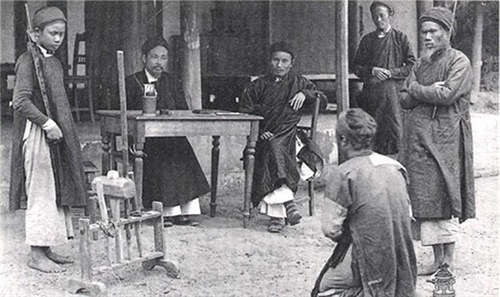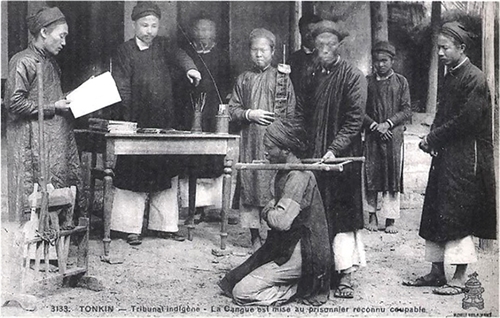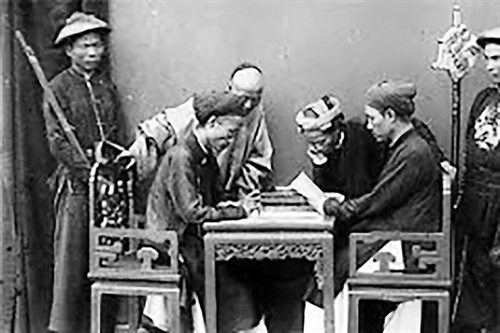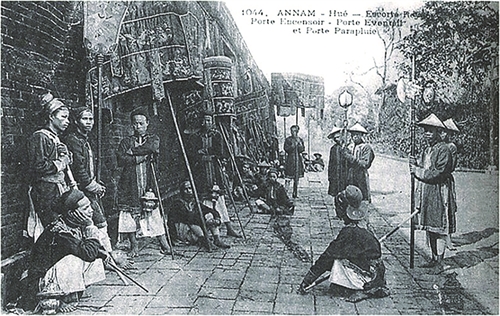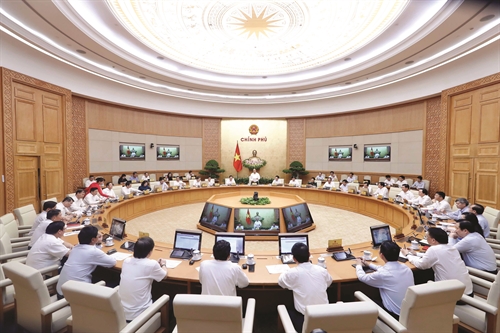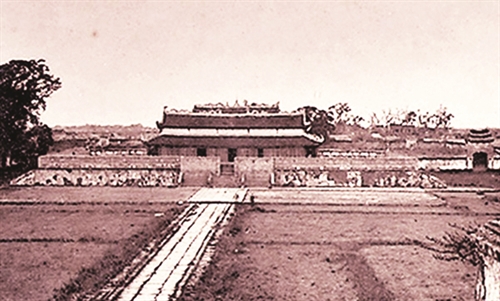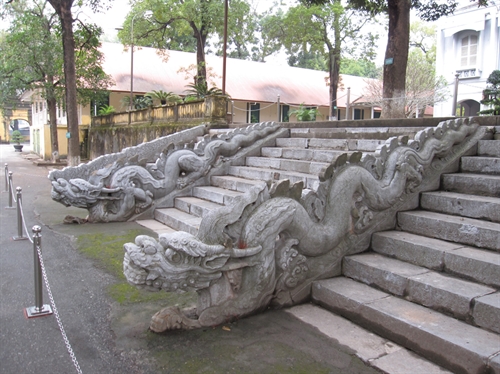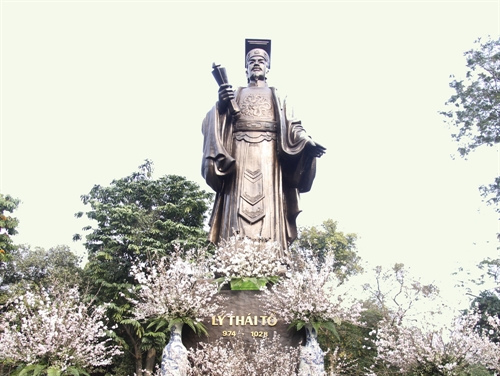Pham Thi Thu Hien, LL.M
Hanoi Law University
Process of recruiting mandarins through “khoa cu” (competition-based examinations) under the Nguyen dynasty (1802-1884)
The competition-based examination regime was introduced in Vietnam very early in 1075 when the Ly dynasty opened for the first time two competition-based examinations: “Minh kinh Bac hoc” and “Nho hoc Tam truong”. From the 15th century to the Nguyen dynasty period, the feudal rulers added many regulations to improve the regime and made it the major mode of recruiting talents.
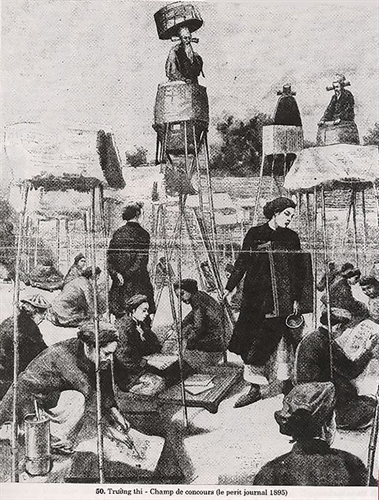 |
| A painting depicting the scene at an examination site during feudal times__Photo: Internet |
The competition-based examination regime under the Nguyen dynasty was composed of two competition-based examinations, regular and irregular. The regular one was held once every three years through three levels: “thi Huong” (inter-provincial examination), “thi Hoi” (pre-court examination) and “thi Dinh” (court examination). Candidates had to take inter-provincial examination first and those who passed pre-court examination would be recruited as mandarins.
In the early stage, the number of mandarins recruited through competition-based examinations was small. So, the feudal state organized irregular examinations called “an khoa” or “che khoa” to select more mandarins.
The examination contents covered not only knowledge but also ruling skills, including “bai kinh sach” (understanding of Confucianism); drafting of legal documents such as “chieu” (royal proclamation), “tau” (report), “so” (petition to the king), or laws; and creating poems and writings (presentation of policies to rule the country).
In addition, “lai vien” (assistants to mandarins) were also recruited for inadequately staffed yamens through literature and math examinations. Those who passed the examinations would be appointed to be “thu lai” (clerk) who would keep papers and books for mandarins. After three years, they were assigned to note down incoming and outgoing documents. After another three years, they were appointed “dien lai” to control the document-drafting regulations, then after three more years, they were conferred “do lai”, managing all “lai vien”.
So, mandarins were recruited on the basis of their talents and virtues to ensure that they possessed adequate ruling skills and professional qualifications to discharge their duties. Mandarins or assistants were appointed to hold given positions and tasks, which were associated with specific responsibilities and obligations. To the king, they had to show absolute loyalty, respect and submission, honestly report the performance results of their assigned tasks, and fulfill their obligations. To the people, they had to make people rich, mobilize and persuade them. To themselves and fellow-mandarins, they had to be full of integrity, severely punish bribe takers, strictly observe office regulations and rules, and to be in harmony with fellow-mandarins.
Like other recruitment modes, recruiting mandarins through competition-based examinations brought about positive results with the selection of talented and virtuous persons to serve the country. It was also hamstrung saw such limitations as fraudulence and partiality in examinations. In order to address such loopholes, the feudal state set a strict supervision mechanism applicable to examination overseers and examinees, from the step of recruitment to the step of roll-call, proclaiming graduates.
Measures to oversee the recruitment of mandarins through competition-based examinations
Measures to supervise mandarins involved in examinations
Mandarins involved in examinations held high grades and ranks in the royal court and were appointed by the king at the proposal of “Bo Lai” (a feudal ministry in charge of organization and personnel affairs) and “Bo Hinh” (another feudal ministry in charge of legal affairs). The mandarins involved in competition-based examinations were classified into two groups:
The first group included “Noi liem” mandarins (mandarins in charge of affairs inside examination sites), who marked examination papers, further divided in to “quan so khao” (preliminary marking mandarins); “quan phuc khao” (second-time marking mandarins) and “quan giam khao” (final marking mandarins) tasked to review examination papers already marked by preliminary marking mandarins and second-time marking mandarins.
The second group consisted of “Ngoai liem” mandarins (mandarins in charge of affairs outside examination sites) who were tasked to receive and stamp on examination books. They include “quan phan khao”, mandarins tasked to review examination papers that had been marked as unqualified and if finding any papers worth reconsidering, to submit them to the “chanh chu khao” (chief examiner) for decision.
“Ngoai liem” mandarins also included “doi the sat” and “doi mat sat”, which were both composed of army men tasked to check examinees and oversee the situation outside examination sites. “Quan khoa dao”, mandarins from Do Sat Vien, a supreme supervisory office established in 1832 by King Minh Menh to oversee all administrative office, sent by the royal court to oversee the examinations; “lai dien”, note-taking officials at examination sites, and “de dieu”, mandarins in charge of taking care of paper work at examination sites, especially examination papers.
The number of mandarins depended on the number of examinees and the number of examination sites. Each mandarin involved in examinations was assigned a specific task, depending on his grade and position in the feudal state. As these mandarins were assigned to enforce the state power, they had to be strictly overseen in order to avoid abuse of power and harassment at examination sites.
First, mandarins involved in examinations were subject to the supreme supervision by the Nguyen feudal state headed by the kings. Through setting examination questions, taking visits to examination sites and studying mandarins’ reports, the kings could oversee mandarins and adjust examination contents or timing. According to a historical record, having noticed the “disorder and poor and trite writings” during a visit to an examination site, King Minh Menh ordered high-ranking mandarins of his six ministries and “Do sat vien” to amend the competition-based examination process and set three different competition-based examinations which were officially applied in 1834.
Besides, the kings could supervise by requesting various ministries to set regulations on handling of violations at examination sites. In the 17th reign year of Minh Menh (1834), Bo Lai promulgated regulations on handling of offending mandarins or examinees, who were respectively demoted or punished with strokes of heavy sticks and hard labor[1].
Second, mandarins’ activities at examination sites were supervised various bodies, including “Do Sat Vien”, “Dai Ly Tu” (the supreme judicial office), and “Bo Hinh”.
According to historical documents, examination overseer Nguyen Ngoc colluded with Nguyen Ba Cung, a Do Sat Vien member, in amending the examination paper of an examinee and burning the examination paper of another. They were both denounced and demoted[2].
In addition, the Nguyen feudal state set specific regulations on objects brought along by mandarins involved in examinations as well as their movement. “Dai Nam thuc luc” (Chronicles of Great Vietnam) recorded the regulations of the 1807 inter-provincial examination: Mandarins in charge of affairs inside examination sites were not allowed to bring along ink sticks and letter-inscribed paper. Mandarins in change of affairs inside and outside examination sties were neither allowed to meet one other for personal business nor permitted to enter and leave the “Vien So Khao” (preliminary examination paper-marking offices) or “Vien Phuc Khao” (examination paper-reviewing offices). Offenders would be subject to hard labor[3].
Third, as mandarins involved in examinations were delegated by the kings the important duty to recruit talents for the nation, the Nguyen feudal state declared that mandarins might oversee one another in order to ensure seriousness of competition-based examinations.
In addition, the “hoi ty”[4] regulation was applied to prevent wrong-doings in competition-based examinations due to family ties. It clearly provided: mandarins involved in examinations, who have relatives as candidates sitting or fellow-mandarins working at the same examination site have to resign from their positions. Those who covered up their relationship would be penalized. Phan Huy Thuc, the head of Bo Le (a feudal ministry in charge of education, culture and health), was demoted one grade[5] for reportedly having recommended his fellow-mandarins to take charge of an examination site in Hanoi where his nephews Phan Huy Thuc and Hoang Dinh Quyen sat examinations and selected as junior bachelor and bachelor, respectively.
Measures to supervise examinees
Examinees included people of different social strata. In order to ensure the selection of talented and virtuous persons, the Vietnamese feudal states in general and the Nguyen dynasty in particular established various mechanisms to strictly oversee examinees from the stage of enrolment to the state of examination sitting.
First, the form of pre-examination test was applied by the Nguyen rulers for the purpose of disqualify persons without real talents and virtues. In their examination papers, examinees had to declare their life stories of three generations. Those who made false declarations would be punished. If they mistook their village-chiefs’ names, they could make corrections right at examination sites. Those who deliberately falsified their life stories or used other persons’ names would be penalized and stripped off their graduation diplomas of previous examinations, if any. Those who were undutiful to their parents, being in deep mourning, committed adultery or incest, etc., would be banned from sitting examinations. Those who concealed their committed crimes would be penalized and stripped off their graduation diplomas of previous examinations, if any. For instance, an examinee, the son of Thanh Oai district chief, who had bagged the first rank in a pre-court examination, was detected as having failed to fully declare his criminal convictions, and therefore, had his examination results annulled and was sentenced to hard labor[6].
These regulations created conditions to widely attract talents while ensuring the morality standards as well as the strictness in recruiting talented and virtuous persons.
Second, the state exercised the supervision over examinees through mandarins at examination sites and Do Sat Vien. Such supervision lasted from the time the examinees began sitting an examination till the examination-paper marking. Examinees were not allowed to talk noisily, ramble disorderly, exchange ideas, note down or do the exercises for others. At a number of examination seats, examinees had to build up their tents at designated places in order to prevent disorder and deliberate selection of places near intelligent fellow examinees to get their advice. Offenders would be penalized with 100 “truong” (strokes of heavy cane). Those who used taboo names in their examination papers would be penalized with 80 “truong”[7]. Besides, in order to prevent fraud, examination papers would be marked by mandarins at examinations then affixed with “giap phung” (overleaf) and “giap trung” (inside examination paper) stamps to prevent addition of new sheets or tear-off.
Third, examinees could oversee one another to ensure fairness. In the course of examination, they were forbidden to bring documents into examination sites. Those who breached this regulation would be charged with the crime of hiding documents and beaten with 100 “truong” and stripped off their bachelor or junior bachelor diplomas, if any. Those who detected and reported such offense would be rewarded[8].
With strict and clear regulations, including those on examination time, subjects, contents, etc. the Nguyen dynasty established a fairly complete supervisory mechanism, ensuring the efficient and smooth operation of examination seats. Such negative phenomena as disorder, giving advice on examination answers or swapping examination answers were handled promptly and publicly.
Especially, the Nguyen dynasty established a system of regulations to inspect and oversee the recruitment of mandarins and their performance of official duties from the central to local level, concentrating on building Do Sat Vien. This was a special trait of the Vietnamese feudal states. For the first time, such office was established to independently perform administrative supervision.
Truly, the Nguyen dynasty’s talent-recruiting mechanism had certain practical values, such as restricting power abuse by mandarins and supplying for the feudal state fully qualified intellectuals. The above-mentioned regulations, along with the mandarin-testing measures and regime of preferential treatment, helped created the then powerful Vietnamese monarchy.-
